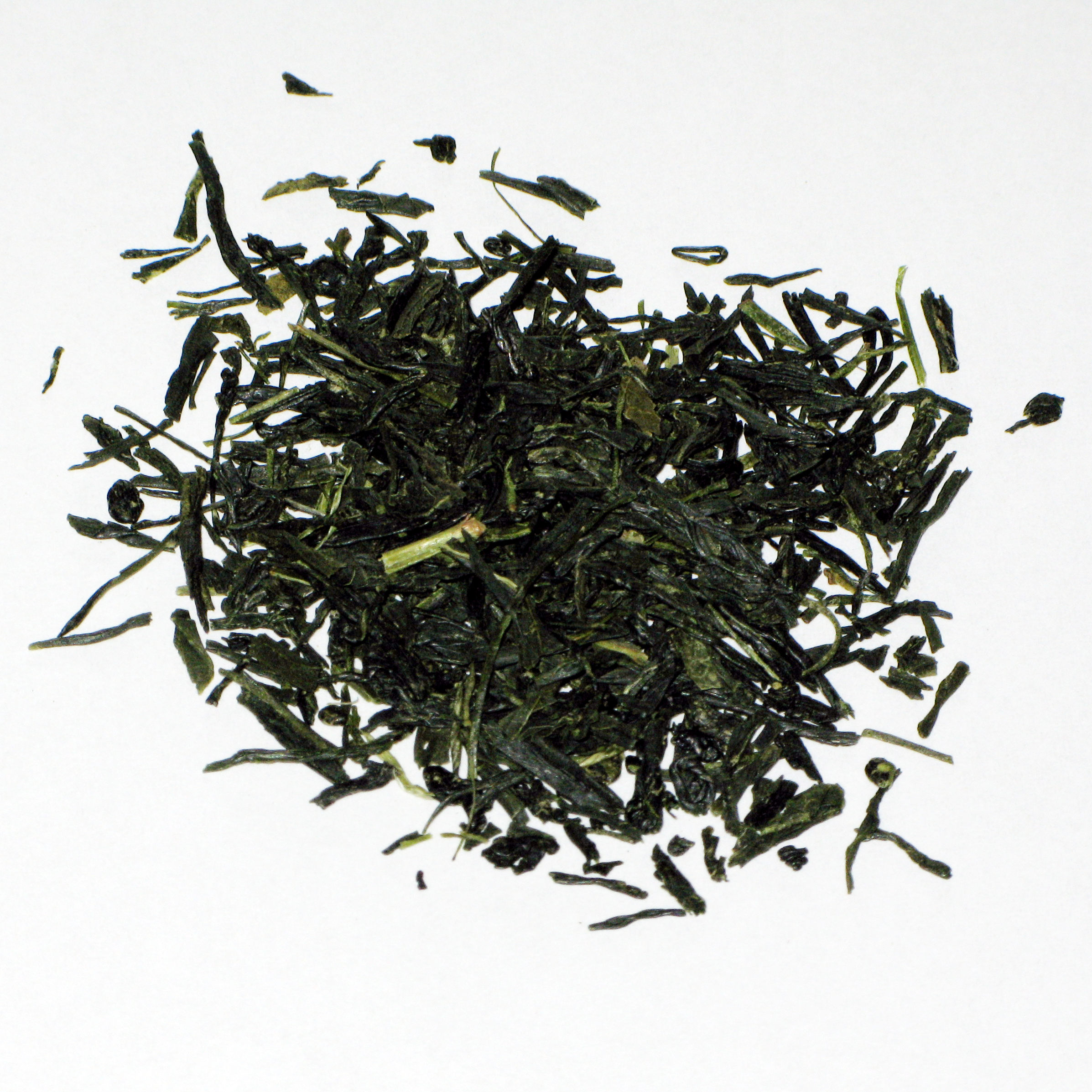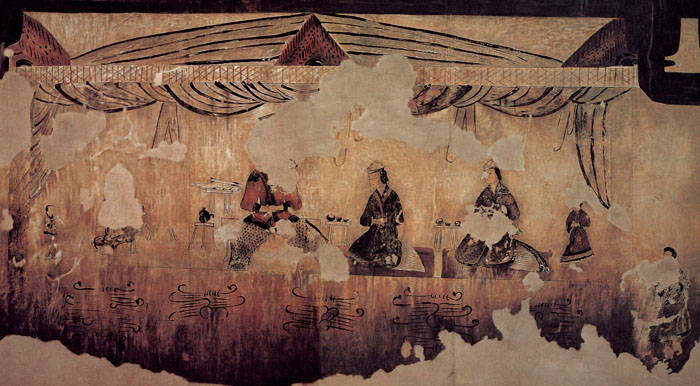|
Sencha
is a type of Japanese green tea (, ) which is prepared by infusing the processed whole tea leaves in hot water. This is as opposed to matcha (), powdered Japanese green tea, where the green tea powder is mixed with hot water and therefore the leaf itself is included in the beverage. Sencha is the most popular tea in Japan. Overview Among the types of Japanese green tea prepared by infusion, sencha is distinguished from such specific types as gyokuro in that it is shaded for a shorter time or not at all, or bancha which is the same tea but harvested later in the season. It is the most popular tea in Japan, representing about 80 percent of the tea produced in the country. The flavour depends upon the season and place where it is produced, but #Shincha, shincha, or 'new tea' from the first flush of the year, is considered the most delicious. Tea-picking in Japan begins in the south, gradually moving north with the spring warmth. During the winter, tea plants store nutrients, and ... [...More Info...] [...Related Items...] OR: [Wikipedia] [Google] [Baidu] |
Tea Culture In Japan
Tea (茶, ''cha'') is an important part of Japanese culture. It first appeared in the Nara period (710–794), introduced to the archipelago by ambassadors returning from China, but its real development came later, from the end of the 12th century, when its consumption spread to Zen temples, also following China's example; it was then powdered tea that was drunk after being beaten (called matcha today). In the Middle Ages, tea became a common drink for the elite, and in the 16th century, the art of the "East Asian tea ceremony, tea ceremony" was formalized. It is now one of the most emblematic elements of Japanese culture, whose influence extends beyond the simple context of tea drinking. Tea-growing developed in the pre-modern era, particularly during the Edo period (1603–1868), when tea became a popular beverage consumed by all strata of society. New ways of processing and consuming tea leaves were developed, starting with sencha, a steamed oxidation-stopped brew that became ... [...More Info...] [...Related Items...] OR: [Wikipedia] [Google] [Baidu] |
Baisao
(1675–1763) was a Japanese Buddhist monk of the Ōbaku school of Zen Buddhism, who became famous for traveling around Kyoto selling tea. The veneration of Baisao during and after his lifetime helped to popularize ''sencha'' tea and led to the creation of ''Senchadō''. Names Baisao went by many names during his lifetime, as was common at the time. As a child, he was known as Shibayama Kikusen. When he became a monk, his Zen priest name was Gekkai Gensho. Baisao, the nickname by which he is popularly known, means "old tea seller." He acquired this name from his act of making tea in the Kyoto area. Later in his life, he denounced his priesthood and adopted the lay name of Ko Yugai. Early life Baisao was born in the town of Hasuike in what was then Hizen Province. His father died when he was nine years old. Baisao became a Zen Buddhist monk at Ryushinji, an Ōbaku temple. His teacher, Kerin Doryo, had received instruction directly from Ingen, the founder of the Ōbaku sc ... [...More Info...] [...Related Items...] OR: [Wikipedia] [Google] [Baidu] |
Japanese Green Tea
Green tea is a type of tea made from the leaves and buds of the ''Camellia sinensis'' that have not undergone the withering and oxidation process that creates oolong teas and black teas. Green tea originated in China in the late 1st millennium BC, and since then its production and manufacture has spread to other countries in East Asia. Several varieties of green tea exist, which differ substantially based on the variety of ''C. sinensis'' used, growing conditions, horticultural methods, production processing, and time of harvest. While it may slightly lower blood pressure and improve alertness, current scientific evidence does not support most health benefit claims, and excessive intake of green tea extracts can cause liver damage and other side effects. History Tea consumption has its legendary origins in China during the reign of mythological Emperor Shennong. A book written by Lu Yu in 618–907 AD, ''The Classic of Tea'' ( zh, t=茶 經, s=, p=chájīng), is considered ... [...More Info...] [...Related Items...] OR: [Wikipedia] [Google] [Baidu] |
Green Tea
Green tea is a type of tea made from the leaves and buds of the '' Camellia sinensis'' that have not undergone the withering and oxidation process that creates oolong teas and black teas. Green tea originated in China in the late 1st millennium BC, and since then its production and manufacture has spread to other countries in East Asia. Several varieties of green tea exist, which differ substantially based on the variety of ''C. sinensis'' used, growing conditions, horticultural methods, production processing, and time of harvest. While it may slightly lower blood pressure and improve alertness, current scientific evidence does not support most health benefit claims, and excessive intake of green tea extracts can cause liver damage and other side effects. History Tea consumption has its legendary origins in China during the reign of mythological Emperor Shennong. A book written by Lu Yu in 618–907 AD, '' The Classic of Tea'' ( zh, t= 茶 經, s=, p=chájīng), ... [...More Info...] [...Related Items...] OR: [Wikipedia] [Google] [Baidu] |
Gyokuro
is a type of green tea from Japan. It differs from the standard ''sencha'' (a classic green tea grown in the sun) in being grown under the shade rather than the full sun. The name "gyokuro" translates as "jewel dew" (or "jade dew"). According to the Japan Tea Central Association, gyokuro is defined as "a tea manufactured in the same manner as sencha from tea leaves picked from covered tea gardens that are almost completely shaded from sunlight for about 20 days using covering materials such as reed screens, straw, or shading nets, from the time when the new shoots of the first flush start to grow." While most sencha is from the cultivar of ''Camellia sinensis'', gyokuro is often made from a specialized variety such as Asahi, Okumidori, Yamakai, and Saemidori. Most gyokuro is grown in the Fukuoka Prefecture, Fukuoka, Kyoto Prefecture, Kyoto, and Mie Prefecture, Mie prefectures. Gyokuro tea production dates back to the 1830s, when the merchant Yamamoto Kahei discovered some Japan ... [...More Info...] [...Related Items...] OR: [Wikipedia] [Google] [Baidu] |
緑茶
Green tea is a type of tea made from the leaves and buds of the ''Camellia sinensis'' that have not undergone the withering and oxidation process that creates oolong teas and black teas. Green tea originated in China in the late 1st millennium BC, and since then its production and manufacture has spread to other countries in East Asia. Several varieties of green tea exist, which differ substantially based on the variety of ''C. sinensis'' used, growing conditions, horticultural methods, production processing, and time of harvest. While it may slightly lower blood pressure and improve alertness, current scientific evidence does not support most health benefit claims, and excessive intake of green tea extracts can cause liver damage and other side effects. History Tea consumption has its legendary origins in China during the reign of mythological Emperor Shennong. A book written by Lu Yu in 618–907 AD, ''The Classic of Tea'' ( zh, t=茶 經, s=, p=chájīng), is considered ... [...More Info...] [...Related Items...] OR: [Wikipedia] [Google] [Baidu] |
Green Tea
Green tea is a type of tea made from the leaves and buds of the '' Camellia sinensis'' that have not undergone the withering and oxidation process that creates oolong teas and black teas. Green tea originated in China in the late 1st millennium BC, and since then its production and manufacture has spread to other countries in East Asia. Several varieties of green tea exist, which differ substantially based on the variety of ''C. sinensis'' used, growing conditions, horticultural methods, production processing, and time of harvest. While it may slightly lower blood pressure and improve alertness, current scientific evidence does not support most health benefit claims, and excessive intake of green tea extracts can cause liver damage and other side effects. History Tea consumption has its legendary origins in China during the reign of mythological Emperor Shennong. A book written by Lu Yu in 618–907 AD, '' The Classic of Tea'' ( zh, t= 茶 經, s=, p=chájīng), ... [...More Info...] [...Related Items...] OR: [Wikipedia] [Google] [Baidu] |
Gyokuro
is a type of green tea from Japan. It differs from the standard ''sencha'' (a classic green tea grown in the sun) in being grown under the shade rather than the full sun. The name "gyokuro" translates as "jewel dew" (or "jade dew"). According to the Japan Tea Central Association, gyokuro is defined as "a tea manufactured in the same manner as sencha from tea leaves picked from covered tea gardens that are almost completely shaded from sunlight for about 20 days using covering materials such as reed screens, straw, or shading nets, from the time when the new shoots of the first flush start to grow." While most sencha is from the cultivar of ''Camellia sinensis'', gyokuro is often made from a specialized variety such as Asahi, Okumidori, Yamakai, and Saemidori. Most gyokuro is grown in the Fukuoka Prefecture, Fukuoka, Kyoto Prefecture, Kyoto, and Mie Prefecture, Mie prefectures. Gyokuro tea production dates back to the 1830s, when the merchant Yamamoto Kahei discovered some Japan ... [...More Info...] [...Related Items...] OR: [Wikipedia] [Google] [Baidu] |
Senchadō
is a Japanese variant of ''chadō'' ("way of tea"). It involves the preparation and drinking of ''sencha'' green tea, especially the high grade ''gyokuro'' type. History Towards the end of the 17th century in the Edo period, Chinese merchants visiting Nagasaki showed how brewed tea should be drunk, as practised in the Ming dynasty court. This practise of the Chinese tea culture spread in the 18th century until the beginning of the Meiji era, particularly among Scholar-official, literati merchants, in the form of friends meeting in a less formal atmosphere than the ''chanoyu''. Appreciation of painting and literacy objects then took on particular importance. These meetings, often followed by genuine meals, were the opportunity to admire the host's collections, most often composed of objects imported from China or made in Japan in Chinese style called ''karamono''. In difference to the preparation of ''matcha'' tea, which is powdered, ''sencha'' is prepared using small leaf t ... [...More Info...] [...Related Items...] OR: [Wikipedia] [Google] [Baidu] |
Matcha
is a finely ground powder of green tea specially processed from shade-grown tea leaves. Shade growing gives matcha its characteristic bright green color and strong umami flavor. Matcha is typically consumed suspended in hot water. Matcha originated in China, but the production of the raw material for matcha was banned in China in the 14th century. Shade growing was invented in Japan in the 16th century and most matcha is produced there today. The traditional Japanese tea ceremony, typically known as or , centers on the preparation, serving and drinking of matcha as hot tea, and embodies a meditative and spiritual practice. Matcha is also used to flavor and dye foods such as ''mochi'' and ''soba'' noodles, green tea ice cream, matcha lattes, and a variety of Japanese ''wagashi'' confectionery. For this purpose, matcha made green by color additives instead of expensive shade-grown matcha is often used. Definition Strict definitions of matcha are given by the International O ... [...More Info...] [...Related Items...] OR: [Wikipedia] [Google] [Baidu] |








